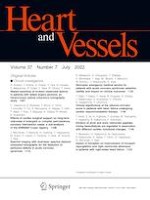Erschienen in:

10.01.2022 | Original Article
Pulmonary vascular resistance and compliance in pulmonary blood flow alterations in children with congenital heart disease
verfasst von:
Yuka Iwaya, Jun Muneuchi, Yuichiro Sugitani, Mamie Watanabe
Erschienen in:
Heart and Vessels
|
Ausgabe 7/2022
Einloggen, um Zugang zu erhalten
Abstract
There is a unique hyperbolic relationship between pulmonary vascular resistance (Rp) and compliance (Cp); however, the characteristics of this coupling curve in pulmonary blood flow alterations remains unknown in children with congenital heart disease. We aimed to explore the Rp–Cp coupling and resistant-compliance (RC) time among them. We retrospectively reviewed catheterization data and calculated Rp and Cp in 217 subjects with ventricular septal defect. Median age and weight at catheterization were 2.8 (1.7–4.4) months and 4.3 (3.7–5.3) kg, respectively. Pulmonary hemodynamic parameters were as follows: mean pulmonary arterial pressure: 36 (28–43) mmHg; the amount of pulmonary blood flow (Qp): 14.2 (11.6–17.6) L/min/m2; Rp: 1.95 (1.38–2.59) Wood unit m2; Cp: 2.98 (2.42–3.88) mmHg/mL/m2; and RC time: 0.35 (0.30–0.40) s. RC time remained unchanged according to alterations in Qp (P = 0.206); however, the relationship between logarithm transformations of Rp and Cp showed more steeper according to an increase in Qp. The pulmonary circulation depends upon Cp rather than Rp according to the degree of Qp despite the constancy in RC time. We should take both Rp and Cp into consideration when evaluating the pulmonary circulation among children with congenital heart disease.